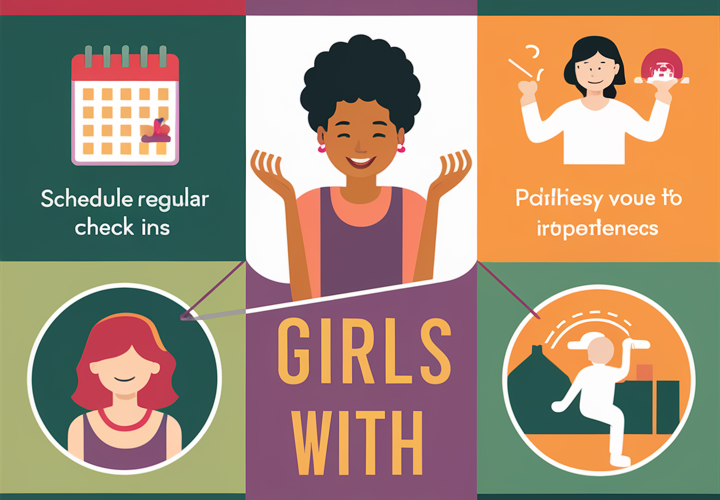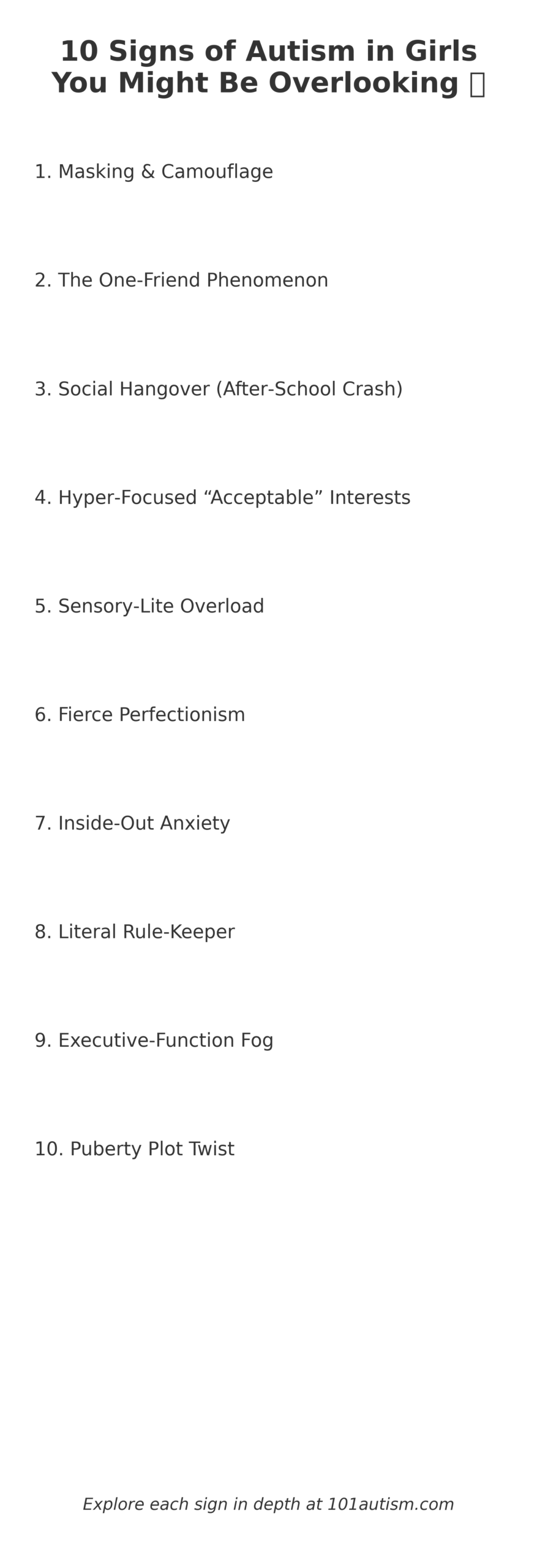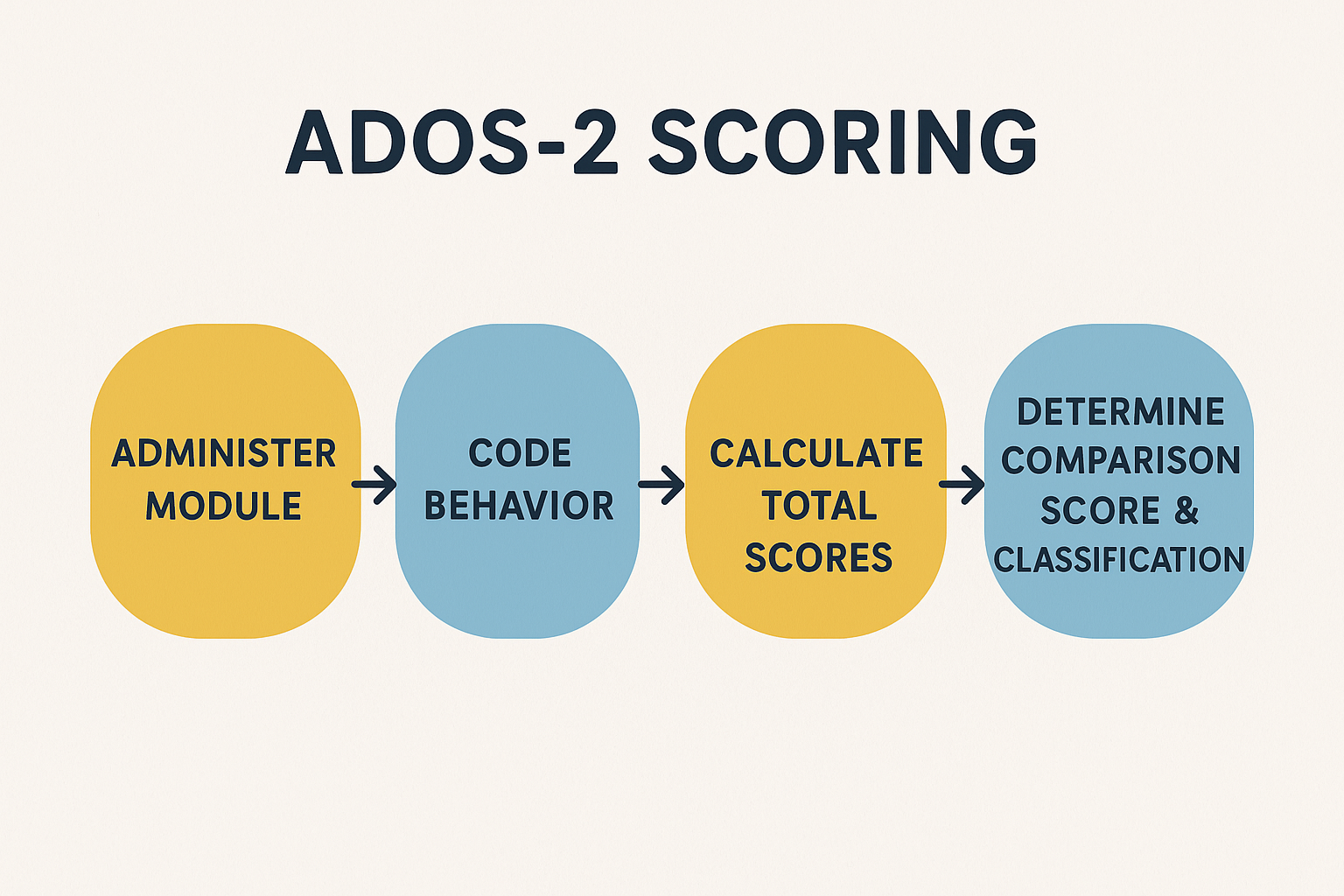10 Signs of Autism in Girls You Might Be Overlooking 💖

Picture this: your daughter beams all day at school. She wins “Quiet Achiever” awards. Then she dissolves into tears the minute she walks through the front door. You wonder, Is it just nerves? Teenage drama? Maybe—yet it can also be autism hiding behind a brilliant smile.
This guide is your friendly flashlight. Let’s explore ten subtle clues. Many families, and even pros, often miss them. Plus, discover gentle ways to support your girl if these signs ring true.

- 1. Masking & Camouflage 🎭
- 2. The One‑Friend Rule 🤝
- 3. Social Hangover 🙃
- 4. Hyper‑Focused “Acceptable” Interests 📚
- 5. Sensory‑Lite Overload 🔊
- 6. Fierce Perfectionism ✔️
- 7. Inside‑Out Anxiety 💭
- 8. Literal Rule‑Keeper 📏
- 9. Executive‑Function Fog 🗂️
- 10. Puberty Plot Twist 🌪️
- Do Three or More Signs Feel Familiar? 💡
- FAQ 🙋♀️
- Top YouTube Videos
- 1. “10 Female Autistic Traits | AUTISM IN GIRLS” by Olivia Hops
- 2. “How To Spot Autism in High-Masking Women and Girls”
- 3. “10 Overlooked Autistic Traits in Girls/Females”
- 4. “Raising Awareness About the Signs of Autism in Girls”
- 5. “Recognizing Autism Signs in Girls”
- Best Blogs and Articles
- 1. “How to Recognise Autism in Girls” by Attwood & Garnett Events
- 2. “Autism in Girls: Why Signs of Neurodivergence are Overlooked” by ADDitude Magazine
- 3. “Eight Often-Overlooked Signs of Autism in Women” from Opya Care
- 4. “10 Signs Your Child May Be on the Autism Spectrum” by Celebration Speech Group
1. Masking & Camouflage 🎭
Imagine acting 24/7. Your daughter watches classmates, copies their slang, laughs on cue, and scripts small talk in her head like TikTok drafts. Teachers see a “model student”; she feels drained by lunchtime.
Try this: Offer a judgment‑free “decompression zone” after school—dim lights, noise‑canceling headphones, zero questions for 30 minutes. Her nervous system will thank you.
2. The One‑Friend Rule 🤝
Instead of a huge squad, she champions one epic BFF or tumbles through intense mini‑friendships that burn bright, then fizzle. Why? Unspoken social rules shift faster than she can track.
Related read: Friendship & Autism: Why “Just Join In” Rarely Works
3. Social Hangover 🙃
Ever notice meltdowns, shutdowns, or total silence right after a “perfect” school day? That’s a social battery running on fumes.
Pro tip: Instead of “How was school?” try, “Want a snack while you chill?” Nourish first, talk later.
4. Hyper‑Focused “Acceptable” Interests 📚
Dinosaurs and trains get flagged as “special interests.” However, deep dives into K‑pop lore, makeup chemistry, vintage fashion, or Minecraft architecture slide under the radar. Intensity > topic.
DIY idea: Invite her to teach the family one cool fact from her passion at dinner—it celebrates her expertise.
5. Sensory‑Lite Overload 🔊
Fluorescent lights trigger migraines; perfume in the hall feels like a jump‑scare. These quiet sensory hits build until she snaps or shuts down.
Next read: DIY Sensory‑Friendly Home Hacks
6. Fierce Perfectionism ✔️
Straight‑A’s, tidy desk, curated Insta feed—yet one tiny mistake sends her spiralling into self‑blame. Perfectionism is a shield that masks confusion and anxiety.
7. Inside‑Out Anxiety 💭
Girls on the spectrum often internalise stress as tummy aches, insomnia, or sudden mood swings. Eating disorders and depression can tag along without an obvious cause.
8. Literal Rule‑Keeper 📏
Sarcasm? Meh. Rule books? Chef’s kiss. She may correct classmates who bend the rules and feel betrayed if plans change last minute.
Family hack: Use clear language—“We’ll leave around 4 p.m., maybe 4:15” instead of “We’ll go later.”
9. Executive‑Function Fog 🗂️
Can quote every BTS lyric yet loses the same maths worksheet twice. Task‑switching, organisation, and time‑tracking are heavy lifts, not laziness.
Toolbox: Visual planners, phone reminders, and colour‑coded folders work wonders.
10. Puberty Plot Twist 🌪️
Hormones crank sensory sensitivity to 11, making social hierarchies feel like a Marvel multiverse. Masking fatigue can peak here, so fresh support matters.
Explore: Next Steps After an Autism Evaluation
Do Three or More Signs Feel Familiar? 💡
| Step | What to Do | Fast Link |
|---|---|---|
| 1 | Take a Screening – The AQ‑10 is a quick start (not a diagnosis) | Autism Test |
| 2 | Track Patterns – Jot triggers, frequency, recovery time | Free printable in our Resource Library |
| 3 | Find a Specialist – Look for clinicians trained in female presentations | Evaluation Centers by State |
| 4 | Build Support – Therapy, peer groups, sensory‑friendly hobbies | Browse Living with Autism Stories |
Remember: autism isn’t a flaw. It’s a different operating system, and the right user manual unlocks amazing strengths.
FAQ 🙋♀️
Is masking the same as “high‑functioning” autism?
Nope. Masking hides struggles; it doesn’t erase them. Chronic masking can lead to burnout.
Can girls “grow out” of autism?
Autism is lifelong, but with support, many challenges become manageable, and strengths shine.
ADHD or autism—or both?
Overlap is common—comprehensive assessments screen for both conditions.
Keep Learning 📚
Top YouTube Videos
1. “10 Female Autistic Traits | AUTISM IN GIRLS” by Olivia Hops
This video offers a personal perspective from Olivia Hops, who was diagnosed with autism at age 24. She covers ten autistic traits that commonly affect females, including:
- Sensory issues (from sheet preferences to food sensitivities)
- Mental health challenges often co-occur with autism
- Inflexibility and difficulty with change
- Social struggles that may be masked
- Selective mutism
This resource is valuable because it comes from lived experience. It aims to help other females “figure themselves out.” This can potentially change lives through earlier recognition.
2. “How To Spot Autism in High-Masking Women and Girls”
This comprehensive video explains how autism can present differently in women compared to men. It particularly focuses on “high-masking” individuals who may appear socially functional on the surface. The video discusses:
- Social challenges that manifest uniquely in girls
- How girls often ruminate or replay social situations
- The exhaustion that comes after social interactions despite appearing to function well
- The contrast between boys’ tendency to isolate versus girls’ desire for social connection despite difficulties
This resource is particularly helpful for understanding the nuanced social presentation in autistic females.
3. “10 Overlooked Autistic Traits in Girls/Females”
This video specifically addresses traits that are commonly missed in the diagnosis process for girls. It emphasizes the importance of early identification to provide appropriate support for development. The focus on overlooked signs makes this an essential resource. It aids parents or professionals who may have missed more subtle indicators of autism in girls9.
4. “Raising Awareness About the Signs of Autism in Girls”
Released for World Autism Day, this video shares the story of 16-year-old Cozy, who struggled for years with undiagnosed autism. It features insights from Dr. Cynthia Martin. She is the senior director of the Autism Center at the Child MIND Institute. Dr. Martin explains why autism is frequently overlooked in girls. The video highlights:
- How girls may be misdiagnosed with anxiety or depression
- The tendency of girls to mask symptoms by mimicking friends’ behaviors
- The life-changing impact of a correct diagnosis
This personal story combined with expert commentary provides both emotional connection and valuable information4.
5. “Recognizing Autism Signs in Girls”
This concise video outlines ten specific signs of autism in girls that are often overlooked:
- Masking autistic traits to fit in socially
- Difficulties with reciprocal social interactions despite engaging in imaginative play
- Intense special interests that may appear more socially acceptable
- Sensory sensitivities expressed differently than in boys
- Social camouflaging through mimicking peers
- High anxiety in social situations
The video emphasizes the importance of early recognition for providing appropriate support5.
Best Blogs and Articles
1. “How to Recognise Autism in Girls” by Attwood & Garnett Events
This comprehensive blog explains why autistic girls often “fly under the radar” of diagnosis due to camouflaging behaviors. It covers:
- How girls observe and analyze peers before engaging socially
- Their tendency to be well-behaved and less disruptive at school
- The “masking” phenomenon where girls appear fine at school but experience meltdowns at home
- The psychological impact of missed diagnosis, including feelings of being “wrong” or “defective”
The article provides valuable insights for both parents and educators on recognizing subtle signs in school and home environments1.
2. “Autism in Girls: Why Signs of Neurodivergence are Overlooked” by ADDitude Magazine
This in-depth article comes from a respected ADHD/neurodiversity publication. It explains the gender gap in autism diagnosis. The article notes that autism is diagnosed four times more commonly in boys. It explores:
- The historical focus on males in autism research and diagnostics
- How autism manifests differently in girls
- The greater social motivation of autistic girls that can mask their challenges
- Different patterns of special interests that may appear more typical
The article offers both research-backed information and practical guidance for supporting neurodivergent girls3.
3. “Eight Often-Overlooked Signs of Autism in Women” from Opya Care
This article addresses the significant problem of misdiagnosis in adult women. It notes that up to 80% of women with autism are initially misdiagnosed. It covers:
- How do diagnostic criteria present differently in adult women
- The more subtle presentation of autism in adults versus children
- The mental tax of masking and its relationship to burnout
- The importance of an appropriate diagnosis for accessing support
This resource is particularly valuable for understanding autism in adult women or adolescent girls approaching adulthood8.
4. “10 Signs Your Child May Be on the Autism Spectrum” by Celebration Speech Group
While not exclusively focused on girls, this blog from speech therapists offers a comprehensive overview of autism signs that apply to all children:
- Avoidance of eye contact
- Lack of early nonverbal communication
- Delayed language skills
- Echolalia (repetition of words or phrases)
- Speech regression
- Specialized interests
- Social isolation
The article emphasizes the importance of early intervention, making it valuable for parents of young children showing early signs6.


